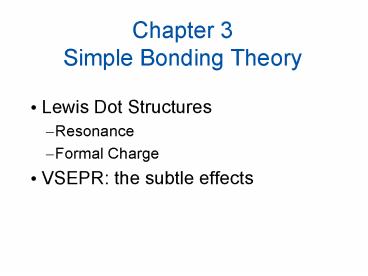Chapter 3 Simple Bonding Theory - PowerPoint PPT Presentation
Title:
Chapter 3 Simple Bonding Theory
Description:
Chapter 3 Simple Bonding Theory Lewis Dot Structures Resonance Formal Charge VSEPR: the subtle effects Lewis Dot Structures 1. Count valence electrons 2. – PowerPoint PPT presentation
Number of Views:59
Avg rating:3.0/5.0
Title: Chapter 3 Simple Bonding Theory
1
Chapter 3Simple Bonding Theory
- Lewis Dot Structures
- Resonance
- Formal Charge
- VSEPR the subtle effects
2
Lewis Dot Structures
- 1. Count valence electrons
- 2. Arrange atoms
- 3. Add bonds
- 4. Add lone pairs
- 5. Convert lone pairs to bonding pairs (octet
rule and exceptions)
3
Lewis Dot Structures
- ExamplesCO2SO3N2OXeF4ClF3PCl6
4
Why does the octet rule work?
5
More complex
- NO2
- NO
6
- Formal Charge
- Group - unshared electrons on atom -
bonds to atom - Example O3
7
Resonance
- Example SO3
8
Resonance and Formal Charge
- Example SCN-
9
Resonance and Formal Charge
- Example SCN-
10
Octet Rule vs. Pi Bonding Trends
- BeF2 and
- BF3
11
Octet Rule vs. Formal Charge
- Always follow octet ruleExceptions? SO42-
12
VSEPR
- Maximize personal space
- CO2, SO3, SO42, PCl5, SF6
- Lone pairs vs. bonding pairs?
- Single bonds vs. multiple bonds?
- Electronegativity effects
13
VSEPR
14
Lone Pair Effects!
15
Pi Bonds vs. Lone Pairs Guess these bond angles.
16
Pi Bonds vs. Lone Pairs
17
Pi Bonds vs. Lone Pairs
Which take up more room lone pairs or a pi bond?
18
Electronegativity Effects
Molecule X-P-X Angle o PF3
97.8 PCl3
100.3 PBr3
101
Explain this trend.
19
Electronegativity Effects
Molecule H-X-H Angle o H2O
104.4 H2S
92.1 H2Se
90.6
Explain this trend.
Molecule X-As-X Angle o AsF3
AsCl3
AsBr3
Predict this trend.































